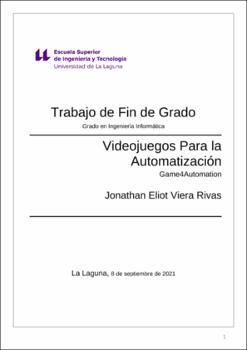Game4Automation
Fecha
2021Resumen
La tecnología basada en autómatas se hace notar cada vez más en la vida cotidiana,
ya sea para tareas sencillas como desplazar una cinta transportadora con alimentos,
como complejas, por ejemplo, el coche autómata de Google. Estas tecnologías buscan
facilitar y mejorar la vida diaria de las personas realizando las tareas específicas para la
que han sido creados con mejor eficiencia, seguridad y detalle. Cabe destacar que se ven
respaldadas principalmente por el uso y avance tecnológico de las empresas que buscan
beneficios a costo de la mano de obra al igual que una ventaja para el futuro consumidor
del producto y apoyadas también por estos últimos por las características nombradas
anteriormente.
El objetivo fundamental que se persigue con la realización de este proyecto es enseñar
y crear la simulación de plantas industriales para demostrar el beneficio que tiene generar
un producto previo antes de la construcción de este. Además, como medio de acercar al
usuario objetivo alojaremos nuestro proyecto en una página web para que sea más
intuitiva y fácil de abordar.
Es necesario destacar que gran parte del proyecto se va a realizar con la plataforma de
Unity que es una herramienta popular de entorno de desarrollo de videojuegos
comerciales y que incluye soporte para VR(realidad virtual) y AR(realidad aumentada), en
concreto, añadiremos a esta plataforma un paquete denominado Game4Automation para
extender esa funcionalidad al diseño e implementación de plantas industriales donde
crearemos nuestras simulaciones de elementos automatizados con los objetos que vienen
por defecto en este Add-On.
El trabajo está estructurado en tres partes: en la primera, se ha realizado la
configuración de los elementos de Game4Automation para la creación de las escenas en
Unity con diferentes niveles de dificultad entre escenas; una segunda parte, que en
conjunto con la primera se trata de añadir el comportamiento y la funcionalidad de los
autómatas generando las PLCs (Controladores Lógicos Programables) con la herramienta
de Visual Studio 2017 y programado en C#; y en la tercera, se ha desarrollado una página
web de autenticación de usuarios para la visualización del contenido y descarga de las
simulaciones haciendo uso de HTML5,CSS y PHP comunicándose a una base de datos
creada con MySQL. Automaton-based technology is increasingly noticeable in daily life, whether for simple
tasks such as moving a conveyor belt with food, or complex tasks, for example, Google's
automaton car. These technologies seek to facilitate and improve people's daily lives by
performing the specific tasks for which they have been created with better efficiency,
safety and detail. It should be noted that they are supported mainly by the use and
technological progress of companies that seek benefits at the cost of labor as well as an
advantage for the future consumer of the product and also supported by the latter due to
the characteristics mentioned above.
The main objective pursued with the realization of this project is to teach and create the
simulation of industrial plants to demonstrate the benefit of generating a previous product
before its construction. In addition, as a means of bringing the target user closer, we will
host our project on a web page to make it more intuitive and easy to approach.
It should be noted that a large part of the project will be carried out with the Unity
platform, which is a popular tool in the commercial video game development environment
and includes support for VR (virtual reality) and AR (augmented reality), specifically, we
will add to this platform a package called Game4Automation to extend this functionality to
the design and implementation of industrial plants where we will create our simulations of
automated elements with the objects that come by default in this Add-On.
The project is structured in three parts: in the first, the configuration of the
Game4Automation elements for the creation of scenes in Unity with different levels of
difficulty between scenes has been carried out; a second part, which together with the first
is to add the behavior and functionality of the automata generating the PLCs
(Programmable Logic Controllers) with the Visual Studio 2017 tool and programmed in C
#; and in the third, a user authentication web page has been developed to view the content
and download the simulations using HTML5, CSS and PHP, communicating with a
database created with MySQL.





